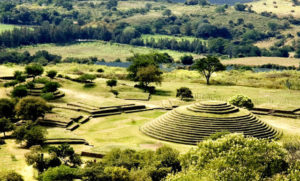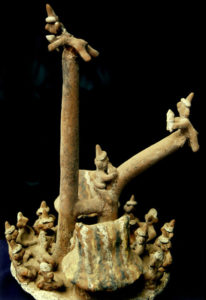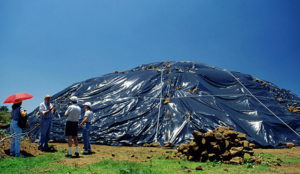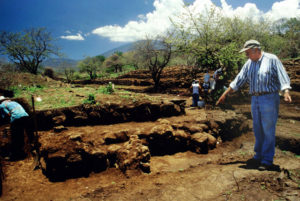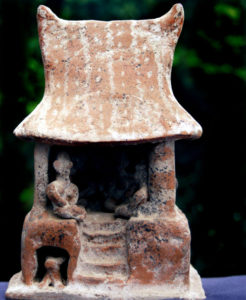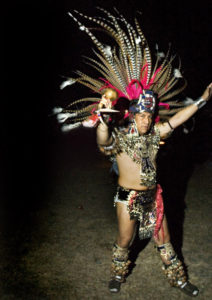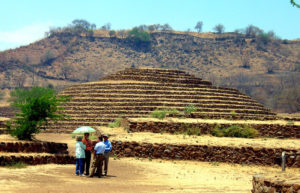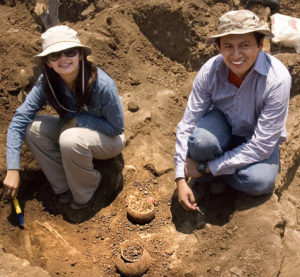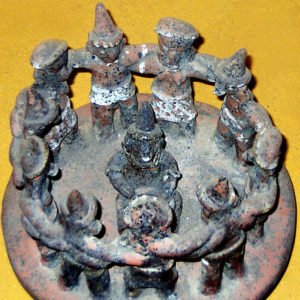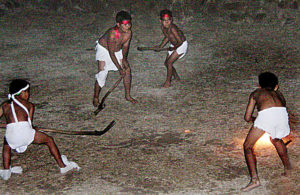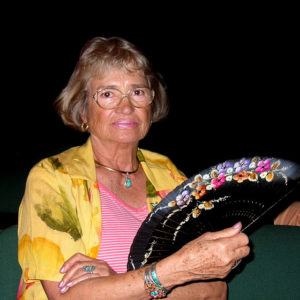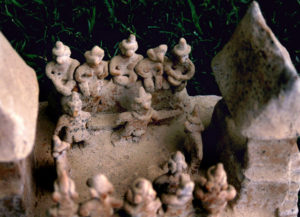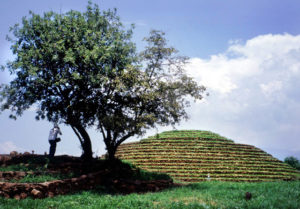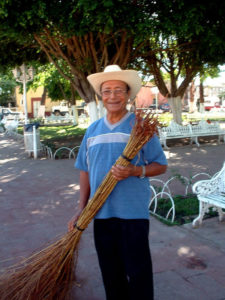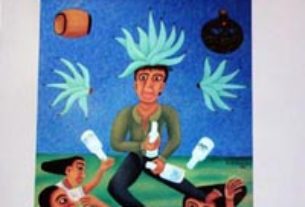Just outside the unassuming little town of Teuchitlán, Jalisco, 40 kilometers due West of Guadalajara, lies one of the most impressive archeological sites in all of western Mexico. However, the first time I saw it — in 1985 — I was anything but impressed.
“Where’s the pyramid?” my friends and I asked a local farmer, who then pointed toward a hill completely overgrown with thorns, brush and skin-irritating dominguilla. A half-hour later, sweating and muttering, we reached the top of what obviously was not a natural hill. “It may be an unusually tall heap of rocks,” we muttered, but that’s all it is, just a heap of rocks.”
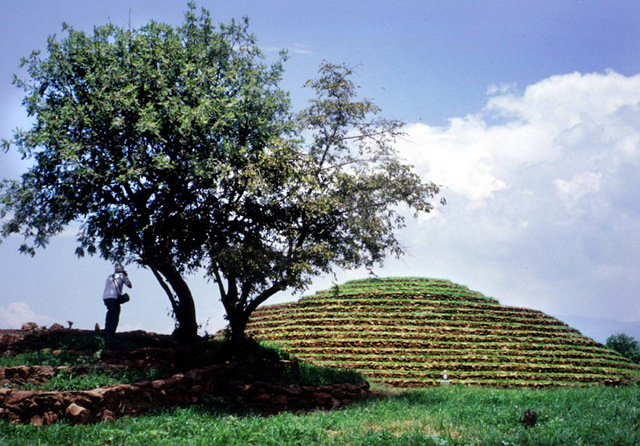 A visitor snaps a photo atop one of the platforms around the circular pyramid at Mexico’s Guachimontones archeological site. In ancient times, these platforms doubled as sites for conducting municipal business as well as entrances to tombs which were open to visitors. © John Pint, 2009
A visitor snaps a photo atop one of the platforms around the circular pyramid at Mexico’s Guachimontones archeological site. In ancient times, these platforms doubled as sites for conducting municipal business as well as entrances to tombs which were open to visitors. © John Pint, 2009
Without realizing it, we had drawn a conclusion similar to what many archeologists of the time thought about the nature of ancient west Mexico and — like them — we couldn’t have been more mistaken.
Unknown to us, two local researchers had looked beneath the surface at Teuchitlán and had discovered that the textbooks were wrong. An amazing civilization — with a style of architecture unique in all the world — had once flourished in those weed-covered hills.
In 1970, a Mexican professor of Art History and an American archeologist, Acelia and Phil Weigand, happened to be visiting Balneario El Rincón, the natural spring from which the Teuchitlán River is born. In the swimming pool, Acelia Weigand found an obsidian blade, which intrigued the couple. “Where has this come from?” they asked themselves. They began hiking in the hills just above the balneario and ended up wandering among the ruins of the pyramids now known as Los Guachimontones. Phil Weigand says, “I stood on the largest pyramid, looked around and thought, ‘This is unexpected.'”
It turned out to be an understatement. The Weigands set aside a summer to explore the pyramids they had found and ended up spending the next 29 years documenting a complex, highly organized society which had begun in western Mexico in 1000 BC and had reached its apogee in 200 AD. They discovered that Teuchitlán had been, in fact, a metropolis of sorts, housing around 25,000 people fed by produce from hundreds of chinampas, small agricultural islands irrigated by an ingenious system of canals, dams and floodgates. In those days the economy was booming, for these people traded in salt from the flats of Sayula and, more importantly, they were situated right next to the third largest obsidian deposits in the world. In fact, they controlled more than 1,000 obsidian mines, from which some 14,000 tons of the precious volcanic glass were extracted. In Teuchitlán’s workshops, skilled craftsmen fashioned the obsidian into knives, spear heads, mirrors of extraordinary quality, unique, ultra-thin earrings and flat-bladed swords called macahuitls, capable of chopping off an enemy’s leg or a horse’s head with one blow. In a society without hard metals, obsidian was the very gift of the gods.
Only in 1999, after intensive mapping and investigation, did the Weigands’ team, which now numbered eight archeologists, begin to excavate and eventually to restore the ruins at Teuchitlán. Today, most of the mounds have been cleared of their jungle-like overgrowth and now you can stroll along the smooth, circular walkways surrounding what were once shining, terraced pyramids built of stones cemented together with a special Mesoamerican mortar which has proven surprisingly resilient and weatherproof.
Teuchitlan: the unearthing of a lost world
Today, more than 150,000 people a year visit the Guachimontones, a local word meaning “mounds where you find plenty of bottle gourds.” A well paved road takes them up the hill from Teuchitlán to a parking area which became too small almost as soon as it was created. Two of the three largest pyramids have been beautifully restored, each with its circular walkway or “patio” and surrounding platforms, which were previously bases for public buildings.
Between the second and the third largest pyramids lies what was, in its day, the largest ball court in Mesoamerica, 111 meters long. The game they played was quite different from the Aztecs’ and, in fact, a form of it, called ulama is still played today in Sinaloa. The ball was a heavy round stone covered in natural rubber which players could hit with their hips. According to archeologists, all the skeletons of males found at Teuchitlán have broken hips. This was not a game for the faint-hearted!
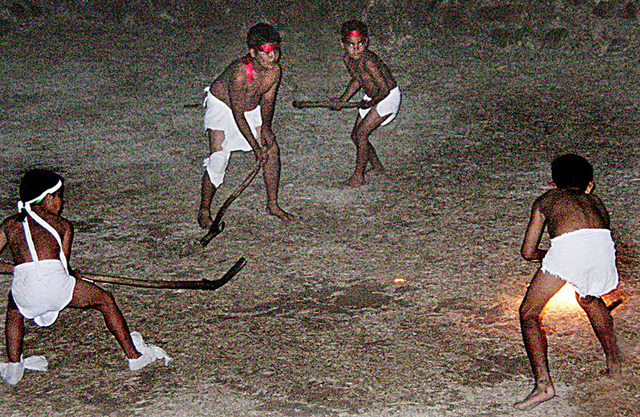 In total darkness, local youngsters play Ulama, a game featuring a flaming wooden ball and hockey-like sticks. Ulama is probably a modern form of the ancient ball game played at the 111-meter-long Guachimontón court in the Jalisco archeological site. © John Pint, 2009
In total darkness, local youngsters play Ulama, a game featuring a flaming wooden ball and hockey-like sticks. Ulama is probably a modern form of the ancient ball game played at the 111-meter-long Guachimontón court in the Jalisco archeological site. © John Pint, 2009
The ball games were often played from sunrise to sunset. Points were gained by getting the ball into a corner in one of the L-shaped legs at each end of the playing field and immobilizing it. Interestingly, points were lost for errors and a team could end up with a negative score if they didn’t play impeccably, a concept that even today might be useful for improving certain modern sports. At the end of the day, the captain of the winning team would receive the great honor of losing his life as a sacrificial victim.
Ancient life in Guachimontones
Wandering about the Guachimontones, we naturally asked ourselves just what was going on in this place 1800 years ago when those same walkways were crowded with the native people of this area, who — for want of a better name — we’ll call the Teuchitlán Nation. What sort of ceremonies took place here and how would it have felt to be a participant?
Some answers to these questions can be found in 25 maquetas or clay models found buried in various sites under the influence of the Teuchitlán Tradition. These extraordinary works of art are around 2,000 years old and reveal what the curious circular architecture was typically used for. Unlike codices, which show stylized figures only understood by experts, the little clay figures give us a three-dimensional look at people chatting with their neighbors, carrying on business or playing everyday games.
Unlike the Aztecs, whose ceremonies resulted in rivers of blood coursing down the sides of their pyramids, the people of Teuchitlán worshiped Ehécatl, a gentle god, who didn’t need human sacrifice to satisfy his ego. On ceremonial days, the ring-shaped “patio” was crowded with people chatting and jostling one another or perhaps linked arm in arm, performing the cadena, or chain dance while listening to groups of musicians. Around this walkway, on evenly spaced terraced platforms, the local VIPs gazed out the doorways of buildings that to western eyes might look typically Chinese. They had tall, pointy, gabled roofs which, along with their wattle-and-daub walls, were carefully plastered and beautifully painted in bright colors. The VIPs chatted with the people in the milling crowd, perhaps discussing the latest score of the ball game taking place in the court located alongside the largest pyramid. Directly to the north, a huge crowd of onlookers watched the events from a steep, terraced hillside, a vantage point from which music from the pyramids could easily be heard.
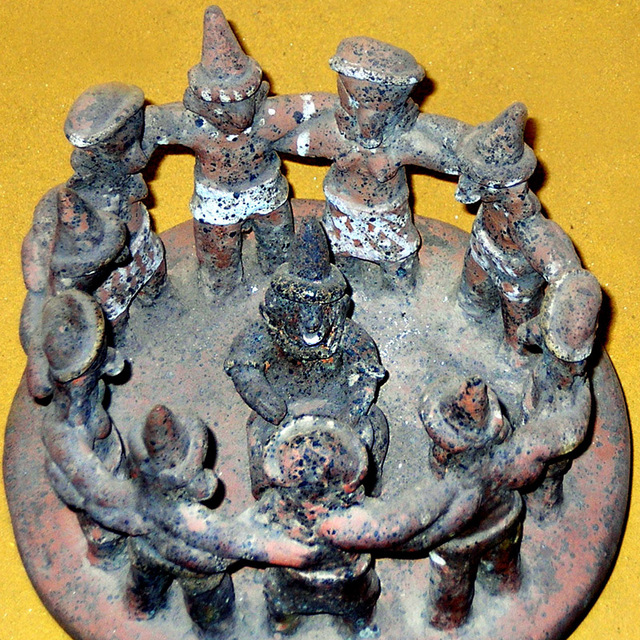 Ancient clay figurines depict the cadena or chain dance which used to take place on the circular walkways around Mexico’s Guachimontones archeological site. © John Pint, 2009
Ancient clay figurines depict the cadena or chain dance which used to take place on the circular walkways around Mexico’s Guachimontones archeological site. © John Pint, 2009
Everyone, of course, was anxiously waiting for the main event of the day to begin. A sturdy pole had been set in the exact center of each steep pyramid. No one today knows exactly what its function was. The clay models show a “flier” balanced on top of the pole, perhaps tied to it so he wouldn’t fall off. He probably represented Ehécatl, the bird man, and, as the clay models show us, a crowd of people pushing on the pole caused him to “fly.” It is also possible that ropes were wound around the pole, as is still done today in Veracruz, and that fliers tied to the ropes and bedecked with feathers, swooped through the air in ever-widening circles, soaring up and down like the graceful birds, finally to land on the circular walkway around the pyramid. The width of this ring was always the same as a second, exterior ring where the buildings were placed, following a complicated geometrical formula; and the diameter of the pyramid was always 2.5 times the width of the walkway.
Unique architecture
These proportions form the basis for Teuchitlán’s formal circular architecture which is unique not only in Mesoamerica, but in the entire world. Nearly two hundred complexes employing this architectural style have been found in western Mexico, making it easy for archeologists to trace the limits of Teuchitlán’s influence.
Another characteristic of these people was the construction of shaft tombs. A very deep hole, just over a meter wide, would be dug, with burial chambers at the bottom. The long, narrow shaft might be up to 20 meters deep, a kind of insurance policy meant to protect the tombs from looting. Unfortunately, this strategy has not dissuaded modern tomb raiders, who have beaten the archeologists to the bottom of just about every shaft tomb in Jalisco. On one of the few occasions when an untouched tomb was found, over 60,000 artifacts were discovered.
Apart from its unusual architecture, the Teuchitlán tradition was distinguished by a particular way of decorating their ceramic pieces, a process now referred to as pseudo-cloisonné. After firing a pot, they would roughen its surface and apply chaute, a mixture of charcoal, oil of sage seed and a glue-like substance from the camote tuber. When this black coating was nearly dry, they carved out certain areas and filled them with bright colors made from inorganic materials such as azurite and red ochre, leaving the raised chaute as a black border. In the past, the colorful panels they created were thought to be merely decorative, but studies have shown that many of these ceramic pieces display glyphs similar to those found in Mexico’s famous codices, meaning that the countless ceramics spirited out of western Mexico over the years probably contain a wealth of valuable information.
 A panoramic view of white-clad visitors conducting workshops and ceremonies at Teuchitlán to celebrate the vernal equinox.The monumental architecture seen at Mexico’s Guachimontones archeological site is based on concentric circles, a style no other civilization on earth has ever adopted. © John Pint, 2009
A panoramic view of white-clad visitors conducting workshops and ceremonies at Teuchitlán to celebrate the vernal equinox.The monumental architecture seen at Mexico’s Guachimontones archeological site is based on concentric circles, a style no other civilization on earth has ever adopted. © John Pint, 2009
The Codex of Ehécatl, for example, found near Teuchitlán by the Norwegian explorer Carl Lumholtz, is now in the American museum of Natural history in New York, along with forty other pieces taken from the same place. This panel depicts the god Ehécatl (the Night Wind) dressed in feathers, his nose pointed like a bird’s beak and with claws for feet. Sad to say, tomb robbers are not interested in the codex-like information on the outside of these pots, only in the monitos (figurines) frequently found among them. When they smash one of these vessels, says Weigand, “It’s like walking into an historical archive, taking out the year 1776, and burning it because your fingers are cold.”
The bright light of the Teuchitlán Tradition began to dim around the year 500 AD for reasons that may never be known, but archeologists tell us that a day came when every building around the circular pyramids was burned to the ground. For a while it was thought that this indicated an abrupt end to that enigmatic civilization, but recent excavations prove that Teuchitlán was inhabited continuously for 2,000 years, from the pre-classical period right through to the post-classical.
Faithful replicas of the clay models showing life around the Guachimontones at their moment of glory are on display at the Museum of La Casa de Cultura Teuchitlán, at number 10, Calle16 de Septiembre, one half block west of the plaza. There’s nothing quite like them anywhere else in Mesoamerica. An excellent 30-minute documentary on Teuchitlán is also shown there daily. The hours are 9 a.m. to 3 p.m., Tuesday to Sunday. Tel: (01 384) 733-0833 and 733-0129. Note that a new, state-of-the-art “interactive museum” is now under construction at the Guachimontones. The building – round like the circular pyramids – was designed by architect Francisco Pérez-Arellano and will cost 28 million pesos. The Teuchitlán archeologists will finally have room to display thousands of artifacts, skeletons and bones found at the site and visitors will plunge into a long, curving tunnel filled with multi-media gadgets for a “journey into Teuchitlán’s past.” The new museum (which comes with a new parking lot as well) is expected to open its doors in early 2010.
The Guachimontones are located 1.2 kilometers northeast of the town. You can get to Teuchitlán from Guadalajara by taking Mexican highway 15 west (toward Nogales) for 25 kilometers and turning left onto highway 70 heading southwest towards Ameca. After 17 kilometers you’ll pass the large sugar refinery at Tala. One and a half kilometers later, turn right onto a road signposted Ahualulco. After 12.7 kilometers you’ll come to the Teuchitlán gas station, where you turn right and drive into town. Three blocks past the plaza, turn right and after 100 meters, make a left onto the road heading north to the Guachimontones. The driving time from Guadalajara is about one hour.

